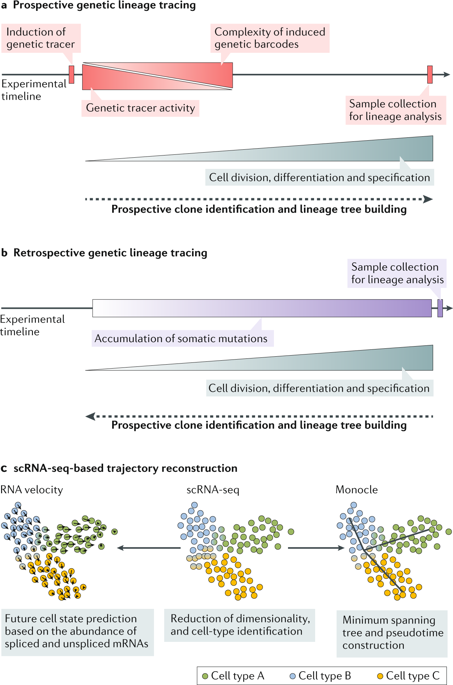当前位置:
X-MOL 学术
›
Nat. Rev. Mol. Cell Biol.
›
论文详情
Our official English website, www.x-mol.net, welcomes your
feedback! (Note: you will need to create a separate account there.)
Unravelling cellular relationships during development and regeneration using genetic lineage tracing.
Nature Reviews Molecular Cell Biology ( IF 81.3 ) Pub Date : 2019-11-05 , DOI: 10.1038/s41580-019-0186-3 Chloé S Baron 1, 2, 3, 4 , Alexander van Oudenaarden 1, 2, 3, 4
Nature Reviews Molecular Cell Biology ( IF 81.3 ) Pub Date : 2019-11-05 , DOI: 10.1038/s41580-019-0186-3 Chloé S Baron 1, 2, 3, 4 , Alexander van Oudenaarden 1, 2, 3, 4
Affiliation

|
Tracking the progeny of single cells is necessary for building lineage trees that recapitulate processes such as embryonic development and stem cell differentiation. In classical lineage tracing experiments, cells are fluorescently labelled to allow identification by microscopy of a limited number of cell clones. To track a larger number of clones in complex tissues, fluorescent proteins are now replaced by heritable DNA barcodes that are read using next-generation sequencing. In prospective lineage tracing, unique DNA barcodes are introduced into single cells through genetic manipulation (using, for example, Cre-mediated recombination or CRISPR-Cas9-mediated editing) and tracked over time. Alternatively, in retrospective lineage tracing, naturally occurring somatic mutations can be used as endogenous DNA barcodes. Finally, single-cell mRNA-sequencing datasets that capture different cell states within a developmental or differentiation trajectory can be used to recapitulate lineages. In this Review, we discuss methods for prospective or retrospective lineage tracing and demonstrate how trajectory reconstruction algorithms can be applied to single-cell mRNA-sequencing datasets to infer developmental or differentiation tracks. We discuss how these approaches are used to understand cell fate during embryogenesis, cell differentiation and tissue regeneration.
中文翻译:

使用遗传谱系追踪揭示发育和再生过程中的细胞关系。
追踪单个细胞的后代对于构建谱系树是必要的,这些谱系树概括了诸如胚胎发育和干细胞分化等过程。在经典谱系追踪实验中,对细胞进行荧光标记,以允许通过显微镜鉴定有限数量的细胞克隆。为了追踪复杂组织中的大量克隆,荧光蛋白现在被可遗传的DNA条形码代替,该条形码可使用下一代测序读取。在预期的谱系追踪中,独特的DNA条码通过遗传操作(例如,使用Cre介导的重组或CRISPR-Cas9介导的编辑)引入单个细胞,并随时间进行跟踪。或者,在追溯谱系追踪中,可以将天然发生的体细胞突变用作内源性DNA条形码。最后,捕获发育或分化轨迹中不同细胞状态的单细胞mRNA测序数据集可用于概括谱系。在这篇综述中,我们讨论了前瞻性或回顾性谱系追踪的方法,并演示了如何将轨迹重建算法应用于单细胞mRNA测序数据集以推断发育或分化轨迹。我们讨论了如何使用这些方法来了解胚胎发生,细胞分化和组织再生过程中的细胞命运。我们讨论前瞻性或回顾性谱系追踪的方法,并演示如何将轨迹重建算法应用于单细胞mRNA测序数据集以推断发育或分化轨迹。我们讨论了如何使用这些方法来了解胚胎发生,细胞分化和组织再生过程中的细胞命运。我们讨论前瞻性或回顾性谱系追踪的方法,并演示如何将轨迹重建算法应用于单细胞mRNA测序数据集以推断发育或分化轨迹。我们讨论如何使用这些方法来了解胚胎发生,细胞分化和组织再生过程中的细胞命运。
更新日期:2019-11-05
中文翻译:

使用遗传谱系追踪揭示发育和再生过程中的细胞关系。
追踪单个细胞的后代对于构建谱系树是必要的,这些谱系树概括了诸如胚胎发育和干细胞分化等过程。在经典谱系追踪实验中,对细胞进行荧光标记,以允许通过显微镜鉴定有限数量的细胞克隆。为了追踪复杂组织中的大量克隆,荧光蛋白现在被可遗传的DNA条形码代替,该条形码可使用下一代测序读取。在预期的谱系追踪中,独特的DNA条码通过遗传操作(例如,使用Cre介导的重组或CRISPR-Cas9介导的编辑)引入单个细胞,并随时间进行跟踪。或者,在追溯谱系追踪中,可以将天然发生的体细胞突变用作内源性DNA条形码。最后,捕获发育或分化轨迹中不同细胞状态的单细胞mRNA测序数据集可用于概括谱系。在这篇综述中,我们讨论了前瞻性或回顾性谱系追踪的方法,并演示了如何将轨迹重建算法应用于单细胞mRNA测序数据集以推断发育或分化轨迹。我们讨论了如何使用这些方法来了解胚胎发生,细胞分化和组织再生过程中的细胞命运。我们讨论前瞻性或回顾性谱系追踪的方法,并演示如何将轨迹重建算法应用于单细胞mRNA测序数据集以推断发育或分化轨迹。我们讨论了如何使用这些方法来了解胚胎发生,细胞分化和组织再生过程中的细胞命运。我们讨论前瞻性或回顾性谱系追踪的方法,并演示如何将轨迹重建算法应用于单细胞mRNA测序数据集以推断发育或分化轨迹。我们讨论如何使用这些方法来了解胚胎发生,细胞分化和组织再生过程中的细胞命运。











































 京公网安备 11010802027423号
京公网安备 11010802027423号